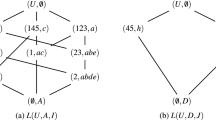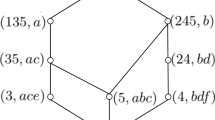Abstract
Rule acquisition and attribute reduction are important research topics in formal concept analysis. Many existing rule-based attribute reduction algorithms are designed to computing all reductions by using discernibility functions and therefore these algorithms are NP-hard. To improve the applicability of rule-based attribute reduction algorithms, firstly, we propose a method to simplify the discernibility matrix such that fewer concepts need to be distinguished. Then a heuristics approach is presented to compute one reduction by using the ordered attributes method. In addition, a novel rule acquisition algorithm for OW-decision rules is presented. Some comparative analyses of the rule acquisition algorithm with the existing algorithms are examined which shows that the algorithms presented in this study behave well. And finally, we select some datasets from UCI datasets for taking experiments and illustrate the effectiveness and efficiency of our proposed reduction algorithms.








Similar content being viewed by others
References
Wille R (1982) Restructuring lattice theory: an approach based on hierarchies of concepts. Ordered Sets D Reidel 83:445–470
Beydoun G (2009) Formal concept analysis for an e-learning semantic web. Expert Syst Appl 36 (8):10952–10961
Formica A (2010) Concept similarity in fuzzy formal concept analysis for semantic web. Int J Uncertain Fuzz Knowl Based Syst 18(2):153–167
Hao F, Pang G, Pei Z (2019) Virtual machines scheduling in mobile edge computing: a formal concept analysis approach. IEEE Trans Sustainable Comput 5(3):319–328
Poelmans J, Elzinga P, Viaene S, Dedene G (2010) Formal concept analysis in knowledge discovery: a survey. In: International conference on conceptual structures, pp 139–153
Zhao YX, Li JH, Liu WQ, Xu WH (2017) Cognitive concept learning from incomplete information. Int J Mach Learn Cybern 8(1):8159–170
Duntsch I, Gediga G (2002) Modal-style operators in qualitative data analysis. In: Proceedings of the 2002 IEEE international conference on data miningc (ICDM’02), IEEE Computer Society, pp 155–162. USA, Washington DC
Yao YY (2004) A comparative study of formal concept analysis and rough set theory in data analysis. In: International conference on rough sets and current trends in computing. Springer, pp 59–68
Yao YY (2004) Concept lattices in rough set theory. In: Processing NAFIPS’04. IEEE annual meeting of the IEEE 2, pp 796–801
Belohlavek R, Dvorak J, Outrata J (2007) Fast factorization by similarity in formal concept analysis of data with fuzzy attributes. J Comput Syst Sci 73(6):1012–1022
Qi JJ, Wei L, Yao YY (2014) Three-way formal concept analysis. International conference on rough sets and knowledge technology, pp 732–741. Springer, Cham
Qi JJ, Wei L, Ren RS (2021) 3-way concept analysis based on 3-valued formal contexts. Cogn Comput:1–13
Chen Z, Liu KY, Yang XB, Fujita H (2022) Random sampling accelerator for attribute reduction. Int J Approx Reason 140:75–91
Chen Y, Liu KY, Song JJ, Fujita H, Yang XB, Qian YH (2020) Attribute group for attribute reduction. Inf Sci 535:64–80
Jiang Z, Liu KY, Yang XB (2020) Accelerator for supervised neighborhood based attribute reduction. Int J Approx Reason 119:122–150
Qian YH, Liang JY, Witold P, Dang CY (2010) Positive approximation: an accelerator for attribute reduction in rough set theory. Artif Intell 174(9-10):597–618
Ganter B, Wille R (1999) Formal concept analysis mathematical foundations. Springer, Berlin
Konecny J (2017) On attribute reduction in concept lattices: methods based on discernibility matrix are outperformed by basic clarification and reduction. Inf Sci 415:199–212
Zhang WX, Wei L, Qi JJ (2005) Attribute reduction theory and approach to concept lattice. Sci China Ser F Inf Sci 48(6):713–726
Wu WZ, Leung Y, Mi JS (2009) Granular computing and knowledge reduction in formal contexts. IEEE Trans Knowl Data Eng 21(10):1461–1474
Ren R, Wei L (2016) The attribute reductions of three-way concept lattices. Knowl Based Syst 99:92–102
Shao MW, Li KW (2017) Attribute reduction in generalized one-sided formal contexts. Inf Sci 378:317–327
Elloumi S, Jaam J, Hasnah A, Jaoua A, Nafkha I (2004) A multi-level conceptual data reduction approach based on the lukasiewicz implication. Inf Sci 163:253–262
Shao MW, Yang HZ, Wu WZ (2015) Knowledge reduction in formal fuzzy contexts. Knowl Based Syst 73:265–275
Cao L, Wei L, Qi JJ (2018) Concept reduction preserving binary relations. Pattern Recogn Artif Intell 31(6):516–524
Dias SM, Vieira NJ (2015) Concept lattices reduction: definition, analysis and classification. Expert Syst Appl 42:7084–7097
Wang X, Zhang WX (2008) Relations of attribute reduction between object and property oriented concept lattices. Knowl Based Syst 21:398–403
Ma JM, Leung Y, Zhang WX (2014) Attribute reductions in object-oriented concept lattices. Int J Mach Learn Cybern 5:789–813
Medina J (2012) Relating attribute reduction in formal, object-oriented and property-oriented concept lattices. Comput Math Appl 64:1992–2002
Qi JJ (2009) Attribute reduction in formal contexts based on a new discernibility matrix. J Appl Math Comput 30(1-2):305–314
Zhang WX, Qiu GF (2005) Uncertain decision making based on rough sets. Publishin of Tsinghua University, Beijing
Wei L, Qi JJ, Zhang WX (2008) Attribute reduction theory of concept lattice based on decision formal contexts. Sci China Ser F Inf Sci 51(7):910–923
Li JY, Wang X, Wu WZ, Xu YH (2017) Attribute reduction in inconsistent formal decision contexts based on congruence relations. Int J Mach Learn Cybern 8:81–94
Li JH, Kumar CA, Mei CL, Wang XZ (2017) Comparison of reduction in formal decision contexts. Int J Approx Reason 80:100–122
Li JH, Mei CL, Lv YJ (2011) Knowledge reduction in decision formal contexts. Knowl Based Syst 24:709–715
Li JH, Mei CL, Lv YJ (2012) Knowledge reduction in formal decision contexts based on an order-preserving mapping. Int J General Syst 41:143–161
Shao MW, Leung Y, Wu WZ (2014) Rule acquisition and complexity reduction in formal decision contexts. Int J Approx Reason 55:259–274
Ren Y, Li JH, Aswani K, Liu WQ (2014) Rule acquisition in formal decision contexts based on formal, object-oriented and property-oriented concept lattices. Sci World J 2014(8):1–10
Qin KY, Li B, Pei (2019) Attribute reduction and rule acquisition of formal decision context based on object (property) oriented concept lattices. Int J Mach Learn Cybern 10(10):2837–2850
Qin KY, Lin H, Jiang YT (2020) Local attribute reductions of formal contexts. Int J Mach Learn Cybern 11(1):81–93
Chen JK, Mi JS, Xie B, Lin YJ (2021) Attribute reduction in formal decision contexts and its application to finite topological spaces. Int J Mach Learn Cybern 12(1):39–52
Fan M, Luo S, Li JH (2022) Network rule extraction under the network formal context based on three-way decision. Appl Intell:1–20
Wang J, Wang J (2001) Reduction algorithms based on discernibility matrix: the ordered attributes method. J Comput Sci and Technol 16(6):489–504
Pawlak Z (1982) Rough sets. Inter J of Comput and Inf Sci 11:341–356
Outrata J, Vychodil V (2012) Fast algorithm for computing fixpoints of Galois connections induced by object-attribute relational data. Inf Sci 185:114–127
Skowron A, Rauszer C (1992) The discernibility matrices and functions in information systems. In: Slowinski R (ed) Intelligent decision support, handbook of applications and advances of the rough sets theory, kluwer, academic, dordrecht, vol 11, pp 331–362
Acknowledgements
This work was supported by the National Natural Science Foundation of China (Grant No. 61976130).
Author information
Authors and Affiliations
Corresponding author
Ethics declarations
Competing interests
The authors declare that they have no known competing financial interests or personal relationships that could have appeared to influence the work reported in this paper.
Additional information
Publisher’s note
Springer Nature remains neutral with regard to jurisdictional claims in published maps and institutional affiliations.
This work is supported by the Natural Science Foundation (Grants No.: 61976130)
Rights and permissions
Springer Nature or its licensor holds exclusive rights to this article under a publishing agreement with the author(s) or other rightsholder(s); author self-archiving of the accepted manuscript version of this article is solely governed by the terms of such publishing agreement and applicable law.
About this article
Cite this article
Hu, Q., Qin, K., Yang, H. et al. A novel approach to attribute reduction and rule acquisition of formal decision context. Appl Intell 53, 13834–13851 (2023). https://doi.org/10.1007/s10489-022-04139-2
Accepted:
Published:
Issue Date:
DOI: https://doi.org/10.1007/s10489-022-04139-2




